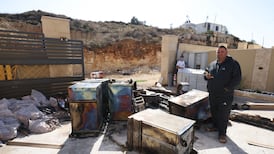On Sunday, hundreds of thousands of Iranians accompanied through the streets of Ahvaz and Mashhad the flag-draped coffin containing the remains of Maj Gen Qassem Suleimani slain by a US drone strike in Baghdad late on Friday.
Mourners dressed in black carried red flags symbolising the blood of martyrs and beat their chests in traditional Shia ritual fashion. His return to his homeland began in Ahvaz, where he began his career as a soldier during the 1980-1988 Iran-Iraq war. Today his body will go to Tehran and the holy city of Qom before burial in his home province of Kerman on Tuesday.
On Saturday, the formal funeral service was held in Baghdad’s Kadhimiyah mosque which contains the tombs of two imams in the line of Shia Islam’s 12 revered interpreters of the Koran. The funeral cortege progressed to the Shia holy city ofKarbala, where in 680 Hussein, the grandson of the Prophet Muhammad was slain in battle with Sunni forces. His death sealed the division between Sunni and Shia over the succession to the prophet and transformed the Shias into a separate sect with its own rituals and with martyrdom as a central theme. Shiism has flourished for a millennia and a half on worship of martyred imams – which distinguishes the sect from the 85 per cent majority Sunni branch.
The cortege moved on to the Shia holy city of Najaf, the location of the shrine of Ali, the prophet’s cousin and son-in-law regarded by Shias as his legitimate successor. Ali was slain in 661 by a rival. There the cortege was met by the son of highly respected Grand Ayatollah Ali Sistani, Iraq’s senior Shia cleric.
Mourning of martyrs
Suliemani’s journey to Karbala and Najaf signified his inscription on the long list of Shia martyrs and is of great importance to Shias who ritually mourn their martyrs throughout the year. He will not be forgotten and the US will not be forgiven for assassinating him.
After he rose to prominence in the elite Quds Force of Iran’s Revolutionary Guard, both the army and the government promoted a Suleimani cult of personality which, along with trumpeted military successes, made him very popular at a time clerics and politicians had become highly unpopular. By adding martyrdom to celebrity, the Shia religious establishment is, essentially, declaring him a saint.
On the Iranian political front, his killing has united against the US pro- and anti-regime Iranians. The government has recently quashed mass protests sparked by a fuel price rise meant to fill state coffers depleted by US sanctions. The sanctions regime was reinstated and toughened following US president Donald Trump’s withdrawal from the six-nation accord limiting Iran’s nuclear programme in exchange for sanctions relief. Iran’s economy, which had grown after the deal came into force in 2016, contracted in 2018 due to a dramatic cut in oil exports and commercial trade. The unemployment rate has soared and Iranians have suffered from a lack of imported medicines and other essential items.
‘Death to America’
During Suliemani’s funeral processions, mourners took up the 1979 revolutionary chant, “Death to America”, which had largely fallen from Iranian lips in recent years. The assassination of Suliemani could shore up popular support for Tehran’s refusal to capitulate to the Trump administration’s demands to end Iran’s nuclear programme, ballistic missile development and regional role as the price for lifting sanctions.
Iranians will expect Suleimani’s martyrdom to be avenged. Tehran has announced this would occur at a time and place of its choosing and would involve action against the US military as Suleimani was a military man. This policy was on Sunday seconded by Lebanon’s Hizbullah leader Hassan Nasrallah who decreed that US civilians should not be harmed.










